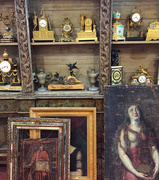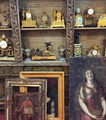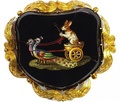
A group of Catholic reliquaries, which supposedly contain tiny pieces of the remains of saints or their clothing, made in the 18th and 19th centuries.

A group of Catholic reliquaries, which supposedly contain tiny pieces of the remains of saints or their clothing, made in the 18th and 19th centuries.

This elaborate reliquary supposedly contains toothpick-sized pieces of the actual wooden cross Jesus Christ was nailed to.

These ceramics made in China around the 11th century were discovered in the ruins of a shipwreck in the Philippines. Some are in pristine condition because they were stacked one top of one another, while others show marks from the growth of undersea animals.

This eye-popping Mid-Century Modern room divider might have been used in a home or a tiki restaurant.

English toy theatres from the 19th century depicted real actors of the day.

A side view of the toy theatre reveals several delicate layers. A child or adult would buy lithographed sheets and glue them to card stock to make the toy actors and scenery.

This French clock from the 1830s features a twisted glass rod to imitate the pouring water of a fountain.

This gigantic Murano-glass chandelier is still fitted with candles, the way it would have been used when first crafted in the early 19th century.

These vintage slicers are still highly regarded among butchers today, particularly for cutting Parma's famous prosciutto.

This chandelier decorated with red and white wooden balls was meant to hang outside during celebrations of Italian unity after the country was established in 1871.

These wardrobes from the early 20th century were originally used in dormitories at private universities or in cabins on passenger ships.

This wardrobe interior contains original labels designating space for furs, lingerie, stockings, gloves, handkerchiefs, and requisites.

During the time of exploration, African ceremonial masks, like these two, were brought back to Europe to be displayed in wunderkammers. It wasn't until Picasso's Cubist phase that Europeans started to see them as art.

This 1939 Fiat race car was designed to reach a high speed of around 100 kilometers per hour (or 62 miles per hour).

This late 17th-century majolica plate features the seal of a Camerlengo, a Vatican administrator who oversees the Catholic Church during the Interregnum, or gap between one pope's death and the election of his successor. Supposedly, the Vatican declined to acquire this plate because the Camerlengo was also the son of a prior pope.
Browsing the stalls at Mercanteinfiera in Parma, Italy, we discovered an endless variety of antiques and vintage items for sale, but some of these treasures were truly incomparable. We’ve put together a slideshow with a few of our best discoveries, ranging from shipwrecked ceramics to vintage race cars. (Read our full report here.)
One comment so far
Leave a Comment or Ask a Question
If you want to identify an item, try posting it in our Show & Tell gallery.







 From Hummingbird Heads to Poison Rings: Indulging Our Antique Jewelry Obsession
From Hummingbird Heads to Poison Rings: Indulging Our Antique Jewelry Obsession
 Where Rococo Meets Space Age: Treasure Hunting at Italy's Premier Antiques Fair
Where Rococo Meets Space Age: Treasure Hunting at Italy's Premier Antiques Fair From Hummingbird Heads to Poison Rings: Indulging Our Antique Jewelry Obsession
From Hummingbird Heads to Poison Rings: Indulging Our Antique Jewelry Obsession American Picker Dream, Part I: Mike Wolfe On His Love Affair With Bikes
American Picker Dream, Part I: Mike Wolfe On His Love Affair With Bikes Mari Tepper: Laying it on the Line
Mari Tepper: Laying it on the Line Nice Ice: Valerie Hammond on the Genteel Charm of Vintage Canadian Costume Jewelry
Nice Ice: Valerie Hammond on the Genteel Charm of Vintage Canadian Costume Jewelry How Jim Heimann Got Crazy for California Architecture
How Jim Heimann Got Crazy for California Architecture Modernist Man: Jock Peters May Be the Most Influential Architect You've Never Heard Of
Modernist Man: Jock Peters May Be the Most Influential Architect You've Never Heard Of Meet Cute: Were Kokeshi Dolls the Models for Hello Kitty, Pokemon, and Be@rbrick?
Meet Cute: Were Kokeshi Dolls the Models for Hello Kitty, Pokemon, and Be@rbrick? When the King of Comedy Posters Set His Surreal Sights on the World of Rock 'n' Roll
When the King of Comedy Posters Set His Surreal Sights on the World of Rock 'n' Roll How One Artist Makes New Art From Old Coloring Books and Found Photos
How One Artist Makes New Art From Old Coloring Books and Found Photos Say Cheese! How Bad Photography Has Changed Our Definition of Good Pictures
Say Cheese! How Bad Photography Has Changed Our Definition of Good Pictures Middle Earthenware: One Family's Quest to Reclaim Its Place in British Pottery History
Middle Earthenware: One Family's Quest to Reclaim Its Place in British Pottery History Fancy Fowl: How an Evil Sea Captain and a Beloved Queen Made the World Crave KFC
Fancy Fowl: How an Evil Sea Captain and a Beloved Queen Made the World Crave KFC
The Mid-Century Modern room divider is stunning, I would put that in my house anyday.